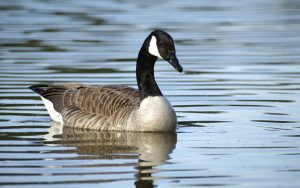Maverick
Sex: Male

Sex: Male
Kingdom: Animalia
Phylum: Chordata
Class: Aves
Order: Anseriformes
Family: Anatidae
Genus: Branta
Species: Branta canadensis
Least Concern
Large wild goose native to the arctic and temperate regions of North America. Lakes, ponds, bays, marshes, fields. Very diverse, using different habitats in different regions; always nests near water, winters where feeding areas are within commuting distance of water. Nesting habitats include tundra, fresh marshes, salt marshes, lakes in wooded country. Often feeds in open fields, especially in winter. In recent years, also resident in city parks, suburban ponds.
Length: 35–46 in (89–117 cm)
Size: About the size of a Heron
Color: Black, Brown, Gray, White
Wing Shape: Fingered, Long
Tail Shape: Rounded, Short, Square-tipped
Basic pattern unmistakable, with white chinstrap on black head and neck. Different populations vary greatly in size and body color (from white-chested to very dark). Compare to Cackling Goose.
Canada geese are herbivores (folivores, granivores and algivores). Their usual diet includes grass, leaves, roots, seeds, berries, and algae. During the periods when nutrients are needed such as breeding season or rearing of the chicks, Canada goose can also consume mollusks, small fish, aquatic invertebrates, crustaceans, and insects.
10-20 years in the wild; 30+ years in captivity.
Canada geese are monogamous, mating once in a lifetime, usually during the second year of their lives. Normally, the breeding season takes place in April-May, sometimes extending into June in areas with a colder climate. When the nesting site is chosen, the female builds the nest and lays 4-7 eggs whereas the male stands guard. Then the female incubates the eggs for about 28 days. As soon as hatched out, the chicks are able to feed, walk, swim and dive. They leave the nest in 1-2 days but stay with their parents for the first year of their lives. The parents help the young to find food, leading the chicks to feeding areas. Depending on the subspecies, chicks of Canada goose are able to fly within 7-9 weeks after hatching out.
Canada geese are very family-oriented, and family groups stay together until mating season. Larger families are dominant over smaller families, and all families are dominant over unpaired or paired birds without families. Multiple families of geese may come together to form a larger group called a gaggle, where birds look out for each other. For example, some birds may act as sentries to watch for predators while the others feed, and sentry duty may rotate among the gaggle members.
Canada geese follow annual migration paths, with some breeding in the northernmost reaches of their range migrating long distances to winter in the south, while others in southern Canada and the United States migrate shorter distances or not at all. During migration, geese may fly in a V formation, which may help conserve energy by reducing wind resistance
The major threats to Canada goose population include toxic pesticides and lead poisoning due to swallowing lead shots. Another serious threat is oil and gas exploration in the Arctic regions where these birds breed. On the other hand, they are threatened with habitat loss because of urban and infrastructure development. Although they are hunted for food and sport around North America, this doesn’t affect the overall population of Canada goose.